Entries Tagged as 'Uncategorized'
September 21st, 2010 · No Comments
Of all of the theater events we attended, 39 Steps was my favorite. The slapstick nature of it kept me engaged, even though I had no idea what was going on during most parts of the play. Also, the actors were able to change character quite easily, and they had to with only four actors on stage. Of course, these characters were completely static, and this play was certainly not the most thought provoking. Being on Piccadilly Circus, the Criterion Theatre was clearly one of the more touristy of the theatres in London, so obviously they were not trying to cater to an erudite British crowd.
The Habit of Art was far to confusing for me, I never really understood the purpose of the group of characters sitting off to the right side of the stage. Most of these characters had extremely minor roles, which was unnecessary to the progression of the plot in my opinion. It was also difficult to tell if the dialogue on center stage was the discussion of the production, or a “play within a play”. It probably didn’t help that I was near-comatose at the time, and this overt intellectualism was not welcome at the time. I think I would have been able to appreciate this play more if it was a matinee and I had been more awake at the time.
The Merry Wives of Windsor was the most difficult for me to sit through. I was pretty jetlagged at the time, and it didn’t help that my grasp of Elizabethan English was already tenuous. Also, standing in a crowd for two and a half hours after having walked over London, mye legs were killing me at that point. However, I though that the recurring innuendo on latin lessons was funny, especially considering my experience in high school latin was very masochistic as well.
Tags: 2010 Tyler · Theatre · Uncategorized
September 21st, 2010 · 1 Comment
For my requisite museums blog, I ventured away from the canon of London museums such as the British Museum and the National and National Portrait Galleries and found an intriguingly fresh museum along Euston Road, The Wellcome Collection. The museum bills itself as “a free destination for the incurably curious” and one can easily see why. The museum is a mix of art, modern art and historical artefacts that focus on human well being; however, the negative, uglier sides of human health are equally represented, if not more than the positive. The museum warns that perhaps this museum may not suit the squeamish very well.
The Wellcome Collection consisted of two main exhibits, one on the history of medicine, represented through the eyes of the arts, sciences and patients, while the other was simply titled, “Skin.” The main goal of the Wellcome Collection is stated clearly: “to consider human existence and what it means to be human.” With this lens in place, the Wellcome Collection proved to be fascinating. The history of medicine exhibit focused on illness, but more importantly the various ways in which humans make sense of disease within their respective societies. The exhibit featured artwork, both classical and modern as well as various antiquated medical tools. One of the most shocking elements in the museum was a line up of twelve to fifteen saws used in the eighteenth century for amputations. The distance we have come as a human race in the field of medicine really does make what think about our existence and how we should define ourselves.
The “Skin” exhibit I felt really drove home the Wellcome Collection’s message as well. The exhibit’s tagline: “consider our existence within our constantly changing skin.” Surely in our history as a species skin is an important aspect of what it means to be a human. I quite like this exhibit because it was so basic in its line rhetoric and process of questioning, yet I felt it very relevant to the museum’s basic philosophy. By walking through the exhibit I realized that there are countless ways to think critically about humanity, even if they are basic and somewhat obvious. I feel that through analyzing the endless characteristics of human-ness present in our skin the museum emphasized this point.
The Wellcome Collection was small and understated, but posed to its viewing public a fascinating idea: think about what it means to be a human. In any religious or secular sense, I find this idea to be both mentally rigorous and rewarding. Also, I generously give my remarks to the curator for constructing such a deeply philosophical idea in just two small understated exhibits. I am very glad I found this museum, and subsequent visits to London may require a quick peek to see which exhibits they choose next that will further symbolize their discourse on humanity.
Tags: 2010 Luke · Uncategorized
September 21st, 2010 · No Comments
One of the most surprising and fascinating aspects of London for me was how international the city is. In most parts of town, when walking around looking for lunch, we are easily able to find restaurants serving food from five or six different cultures. In the East End, a single building was used as a church, then a synagogue, and now a mosque. Walking down the street, I have heard a number of different languages spoken, some that I do not even recognize. Perhaps the most fascinating opportunity we were given to explore the multi-cultural aspect of London was the chance to visit places of worship belonging to a number of different religious groups in London. I found it especially interesting that to observe the ways in which the religious groups attempt to bridge the gaps that inevitably exist in such a multi-cultural, multi-faith city.
The fact that most of our guides mentioned involvement in interfaith projects demonstrates that London’s various religious communities are all dealing with living in a multicultural cities by engaging and trying to understand on another (at least partially). I find it interesting that only the churches that we visited did not describe involvement in interfaith organizations. I am fairly sure that Christians actually do participate. However, all of the other religious groups are minorities in London, and it is likely that Christian groups (and specifically Anglicans) do not feel a need to advertise their involvement to visitors because they do not assume automatically that their visitors are from different religious backgrounds from their own. For minority groups, I think that talking about this involvement to visitors is an important way to express common ground by expressing connections with other groups that the visitors probably associate with or belong to. At the Hindu mandir, our guide also talked about a number of famous leaders from other religious groups who have visited the Mandir (again I think, to find common ground with us).
When we visited a mosque, as our guide told us about Islam he constantly pointed out similarities with Christianity and Judaism. Although these similarities are accurate, he clearly stressed them, because assuming that we came from Jewish or Christian backgrounds, he wanted us to be able to appreciate Islam by relating it to our own traditions. Although the effort probably could have been carried out better, and probably the specific tensions currently surrounding perceptions of Islam, the community at the Mosque clearly makes an effort daily to break down barriers.
Ultimately, I think that by welcoming us in to their worship space learn about their religions, all of the minority groups that we visited expressed a commitment to breaking down some of the barriers with other religious groups.
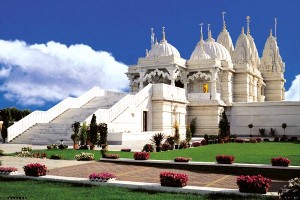
- The Mandir that we visited (from the Mandir’s website)
Tags: 2010 Emily · Uncategorized
September 21st, 2010 · No Comments
One commonality connecting our visits to diverse religious institutions was a certain level of decorum expected of visitors, which was of course implicitly observed by worshippers. In each of these places, visitors could not take any pictures, but there were many other customs which we were asked to observe in respect to each of these places of worship.
For example, in both the Mandir and the Mosque, visitors were expected to take off their shoes before passing beyond the entrance of each of the respective buildings. I feel like I should have asked about this custom while at the Mandir; I understand the justification for this observance of this custom at the Mosque exists because Islamic culture values emphasizing cleanliness. Is it the same justification at the Mandir? And of course, we were expected to not eat pork or smoke before going to the Mosque or Synagogue, due to the respective dietary laws of Islam and Judaism.
It was very interesting to hear about the application of Sharia law in the UK. Most of the Sharia, although observed by faithful Muslims, is not legally codified in the UK. The parts which are legally binding mostly involve marital contracts and business contracts between consenting parties. So, like Christians and Jews (whose religious marriages are recognised by the state), Muslims are allowed to enter these contracts at their behest. It is always interesting to hear the argument that Sharia law should not be allowed in the Western world, despite the fact that these obligations don’t impact anyone except the Muslims who are parties to them. Maybe, if they don’t like Islamic culture being practiced in the West, they should give up other customs which were imported from the Islamic world after the Crusades. Like bathing.
Back what was supposed to be the topic of this blogpost. One major difference between St. Paul’s cathedral and Westminster Abbey on one hand, and the Mandir, Mosque, and Synagogue on the other hand, was that there were burial tombs and cryps in each of the Anglican sites of worship, but none in the Hindu, Muslim, or Jewish sites. But, after thinking about it more, this has to do more with the age of the buildings; the Anglican sites were hundreds of years older than the Muslim, Jewish or Hindu sites.
Tags: 2010 Tyler · Churches and Cathedrals · Uncategorized
September 21st, 2010 · 1 Comment
I’m not much of a history freak, but I think museums are amazing. They serve as a unique interactive learning experience allowing us to actually see and absorb things that we wouldn’t obtain through a textbook or classroom lecture. Seeing artifacts and paintings brings history to life, and this method of learning is preferable by some people and especially for young children for the hands- on experience. It is really cool to be able to walk into a museum, and in London’s case for free, and see something that existed millions of years ago. I’ve always admired to determination of historians to seek the unknown, and figure out when and why something happened, and to openly share this information with the public.
One of my favorite museum trips was earlier on in the month when we visited the Museum of London. I always knew about the Romans, and read about the founding of London and Britain as an empire, but actually physically seeing everything connected all of the random pieces of information in my head. I enjoyed learning about early Roman life, and realizing that we learned cleanliness from them. The women made hair combs, nail clippers, and even tweezers that so closely resemble the beauty essentials women use today. I loved that each floor uncovered different eras of London’s history, which included industrialization, political and social movements, and even fashion.
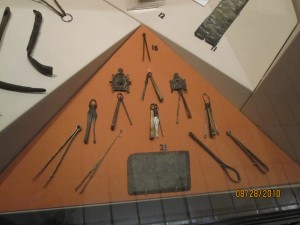
(Roman beauty essentials)
Another one of my favorite museums was the Victoria and Albert museum. Many students disliked this museum the most because it was too hard to navigate, but I actually appreciated the arbitrariness. I was so bored of visiting museums that solely displayed the rich white royalty of England, that is was nice to have a change with something that was completely informal and unplanned. Stumbling room by room through this organized chaos, I realized you could find just about anything in this museum. I was able to admire the fashion styles of Grace Kelly and to jealously look at centuries worth of jewelry worn by generations of rich people.
There were artifacts and sculptures thrown everywhere, it was like a giant garage sale. In the section with mosaics and paintings, we found a mosaic of Rome by Antonio Testa that took him twenty years to complete. This museum was filled with thousands of artifacts, my only question is where did they get all of this stuff from? I was trying to think of a coherent way that they could have organized everything, but honestly it would be impossible. So whether the designer just gave up on figuring out a floor plan, or intended it to be this way, I really enjoyed it.
Tags: 2010 Melissa · Uncategorized
September 21st, 2010 · 1 Comment
Since I’m most of my visits to pubs have been for meals, I’ll use my pub post to talk about the meal that I’ve ordered most often: fish and chips. George Orwell describes food as something that varies from pub to pup: to some extent, this is still the case, however, fish and chips is a constant, and in fact it is very similar from one pub to the next.
The presentation of fish and chips in pubs shows a definite lack of pretension. On the menus, the dish is usually labeled as just “fish and chips,” sometimes, “served with mushy peas.” And what you get on your plate is just that: fried fish, sometimes over the chips, and sometimes next to them, with tarter sauce, but no more fancy sauces or toppings besides those such as catchup and vinegar that are already on the table. Customers are free eat any of the condiments on the table with their fish and chips. My first time ordering fish and chips, I was not sure what mushy peas would be, but they are exactly what their title suggests, definitely mushy, and not very much like vegetables, served simply in a small container or on the plate with the fish and chips. At the Court, which much of our group has frequented, fish and chips meals are offered in medium and large serving sizes. This, as well as the presence of vinegar, catchup etc. shows that customers are familiar with ordering fish and chips, and have specific preferences.
After ordering fish and chips at a few restaurants that are were pubs, I realized that the quality of the same meal decreased dramatically. To be fair however, these restaurants were both in highly touristy areas, one by the British Museum, and the other in Bath. At both, I was served more hard breading than fish, and the fish itself did not taste nearly as fresh. Since the two fish dishes were so similar, I wonder if they got the fish frozen and already breaded from the same provider. The fish and chips at both of these restaurants also cost over seven pounds, as compared to the five or six pounds that I usually spent on the same (and better) meal at pubs. Clearly, the touristy restaurants do not need to worry about providing their customers with good food, because they get new customers who do not know where to find good food every day. The difference in quality demonstrates that people who know where to go, and are truly looking for a good meal go to pubs.
Something else that I noticed about eating meals at pubs, is that although the food is simple, they are certainly not designed for quick meals. After we order, food can take upwards of fifteen minutes to arrive. When I ate lunch with a few other students during a forty-five minute lunch break, we were left with only five or ten minutes to eat after our food arrived, and inevitably we were a little late to get back to class. I think that this is because pubs are truly places to hang out and to relax, instead of simply places to go for a meal. Whether going for an evening out or just a plate of fish and chips for lunch, customers are expected to take their time, and enjoy socializing with the people they are there with, instead of just eating and leaving.
Tags: 2010 Emily · Uncategorized
September 21st, 2010 · 2 Comments
With sunny skies and a temperature of 20 degrees, yesterday was the perfect day to get out of the museums and visit Kew Gardens. To get to the Kew Gardens tube stop, you take the Northern line to Embankment, and transfer to the westbound District line trains terminating at Richmond. The ride from Embankment to Kew Gardens took a little over 30 minutes, so plan to spend at least 2 hours at the gardens to make the trip worthwhile. After leaving the Kew Gardens tube stop, you must take a brisk five minute walk down a tree lined street, to the Victoria gate of the Royal Botanical Gardens.
The entrance fee at the gates is £13.50 for adults, but £11.50 if you bring your student ID. At the entrance, I saw several people showing cards and being allowed quick entrance without buying tickets. Later, when I spoke to a guide I inquired what this card entailed, and the guide explained that many of the denizens of the surrounding area had purchased membership in order to enjoy the privilage of visiting the park for free whenever it was open. Even though the neighborhood by the tube stop was quite scenic and had lots of open public space, it became apparent to me that the ammenities that the park provided made a full membership worthwhile if you lived in the surrounding area.
As you walk down the path from the entrance, you are greeted by the sight of a diverse selection of trees from arround the world, neatly arranged in groves to the sides of the path. Along the way, I spotted what is believed to be the oldest tree in Kew Gardens, a Sweet Chestnut tree thought to have been planted in the early 18th century. The Sweet Chestnut tree is thought to have been introduced from Southern Europe by homesick Romans who were known to use the chestnuts to produce flour and other edibles.
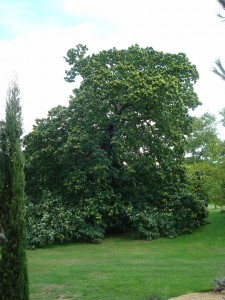
I decided to walk to the southern end of the Gardens, toward the Japanese landscape garden, with a “Chokusi-Mon” replica in the center. Chokusi-Mon means “Gateway to the Imperial Messenger” in Japanese, and this temple was a replica of one in Kyoto.

There was also a peacock just chillin’ to the side of the path, next to a bush! Some of the other visitors, who seeing from their accents were British, passed by and made clicking noises to get the attention of the bird. They were not very sucessful, but it reminded me of Kate Fox’s discussion about how Brits like to talk to pets and animals for as a coping mechanism for their social dis-ease.

Finally, I visited the Princess of Wales Conservatory, which contained several plant selections from several climate zones, including a Tropical Rainforest, Desert, Tropical and Temperate Ferns, and an Orchid room! There were live butterflies in several of the rooms, but I couldn’t take any pictures because I used all of the spare memory on my camera. If you are ever in London again, and want to escape the bustle of the city, go to Kew Gardens!

Tags: 2010 Tyler · Uncategorized
September 21st, 2010 · No Comments
From what I’ve begun to gather, the English (or, Londoners) aren’t particularly fond the French or French culture. I overheard a conversation on the street that ended in, “Do I look bloody French to you?”. Not quite sure of the motivation behind the outburst, but anti-French sentiment, while not rampant, is a visible part of popular English culture. It’s strange, then, that some of London’s most prominent physical elements should mesh so completely with the French formal ideal: parks.
The classic French conception of beauty in nature is that none can exist without the existence of order- of the human hand altering the chaotic natural mass into a structured, geometric product. From what I’ve seen of the layout of Regent’s park, the Brits have just about the same idea. Many people have commented that parks in London seem to be, first and foremost, places to enjoy the beauty of the precisely-planned horticulture. We see meticulously trimmed hedges, flowers planted with regard to color scheme, and white fountains as centerpieces. While running in Regent’s the other afternoon, I saw teams of gardeners replacing soil and adjusting flowerbeds. The beauty lies not only in pure nature, but in the reordering and distribution of it.

http://www.gardens-to-visit.com/2009/02/versailles-2.html
It’s hard to think of a better example of this systematic restructuring than in Versailles. The hedges are pruned to an almost impossible degree of uniformity, the flowers are separated with care, and there are man made monuments throughout (to serve as an even more solid testament to the strength and genius of the designers. The same artistic values and technical skill are visible in Queen Mary’s Garden in Regent’s park.
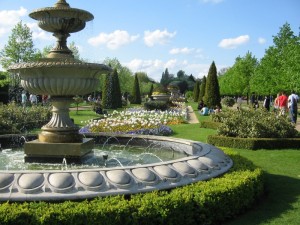
http://www.londonrelocationservices.com/blog/tag/west-london-relocation
The rows and rows of flowers in the garden do not grow in natural patterns, as might be typical in American parks or gardens. Like their French counterparts, the English gardeners have devised color schemes, strict rows, and tight upkeep standards on all the elements of the space (note the uniformity in the hedges around the fountain and the flower patches). These areas of the park are not meant for “fun” in the typical American park sense of the word- we were glared at for tossing a frisbee in the garden a few days ago. They’re a medium of artistic expression, and I’m starting to appreciate them more and more. I do think, however, that instead of badmouthing the French, Londoners should take some time to stop and smell the roses. It’s through these gardens that we can see real, fundamental similarities in an important aspect of the two cultures.
Tags: 2010 Patrick · Uncategorized
September 20th, 2010 · 1 Comment
I’m a slow museum goer. I like to read all of the text as I go through, and when at an art museum, I tend to find a few paintings to focus on for, say fifteen minutes each, looking closely, and then backing up again, trying to discover the secret to the artist’s technique in the brushstrokes. And so I’ve found the process of visiting museums in London frustrating for the same reason that I’ve thoroughly enjoyed the experience: the collections at most of the museums I have visited here are just too expansive to see everything in a single afternoon.
The most extreme example is the Victoria and Albert Museum: each room is overwhelmingly full of objects, and almost every object is accompanied by a full paragraph of text. So fairly early in my visit there, I abandoned trying to read everything and even walked through some rooms without stopping, in order to use my time to really get a sense of the full extent of the museum. Not surprisingly, I really enjoyed the few exhibits were simpler, less cluttered, and more focused, such as the sequence of Peter Rabbit illustrations (which was a fun surprise). However, among the clutter I also stumbled on some amazing contemporary pottery within the Japanese exhibit, simply because it happened to catch my eye. In an entirely different part of the museum I saw some oil sketches by John Constable that looked surprisingly impressionist, compared to his typical, more realistic, complete landscape paintings. Over all, I was able to see plenty that I found interesting, despite skipping items and full exhibits along the way. However, the experience was somewhat stressful, since I knew that I had so little time to see so much.
In some of the art museums that showed mostly paintings I ended up needing to skim the collections as well. On my first visit to the National Gallery, I ended up looking at only the rooms that featured impressionist and post impressionist paintings since I love looking at paintings by these particular artists, and therefore spent a lot of time in front of each individual painting. (I discovered a new favorite Van Gogh painting, and a photo of it is attached to this post.) When I went back about a week later to see the rest of the museum, I still had to skip a lot of paintings and captions in order to get through see a variety. The skimming process inevitably led me to focus on finding the more famous paintings, such as Van Eyke’s Arnolfini Wedding Portrait and Hogarth’s Marriage A La Mode series, and although these were not all that I looked at, I wish I could have spent time looking at more of what the museum had to offer. It’s a strange trade off to be in a museum with a lot of amazing art, but to not get to see all of it because of the sheer quantity and quality throughout. My experience in the Tate Britain was similar, though to a lesser extent: there was an entire wing devoted to Turner paintings, many of which were truly breathtaking to look at, and I found it difficult to decide how to ration my time in order to move on to other parts of the museum.

Van Gogh painting (photo from National Gallery website)

Turner Painting (from Tate website)


The Sir John Soane Museum was an exception because it was much smaller than the other museums that I visited and included very little text. However, I had little access to information about what I was seeing, so I left feeling much less satisfied than when I left the larger museums. I definitely prefer a museum having too much on display that I want to see, rather than not enough. I still cannot figure out whether most museums in London are more text heavy than those in the States, or whether I just read very little of it here simply because there is so much to see. Either way, I think that I could return to a few of the museums that I visited every day for a week, and still have more left to discover there.
Tags: 2010 Emily · Uncategorized
September 20th, 2010 · 1 Comment
The Royal Crescent, located on the outskirts of the town of Bath, is an excellent example of the Georgian style of architecture common in housing built during the 18th century. Designed by John Wood the Younger, the Crescent is similar to much of the architecture in Bloomsbury is that the windows become shorter as you move further up the building. Another Georgian feature are the the Ionic columns between each of the windows, throughout the facade.

The Royal Crescent was built between 1767 and 1774, and was formerly home to British royalty such as Prince Fredrick, Duke of York and Albany. Unfortunately, the Crescent sustained some damage during the World War II bombing raids, as the Ministry of Defense is not located far from Bath. However, this damage is not apparent to the splendid condition that the building is currently in.

One of the most breathtaking views of the Crescent is looking upward from the bottom of the hill, looking past the expansive park above. There was a game of pick up football happening on the far side of the field, and closer to the Crescent park goers were sunbathing and picnicking.
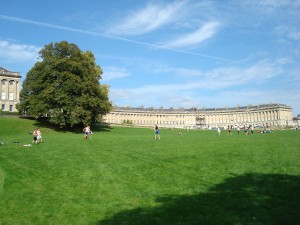
Bath was by far the most scenic town I have ever been to, and I found it hard to put my camera down considering how aesthetically pleasing the sights were.


Tags: 2010 Tyler · Uncategorized

















